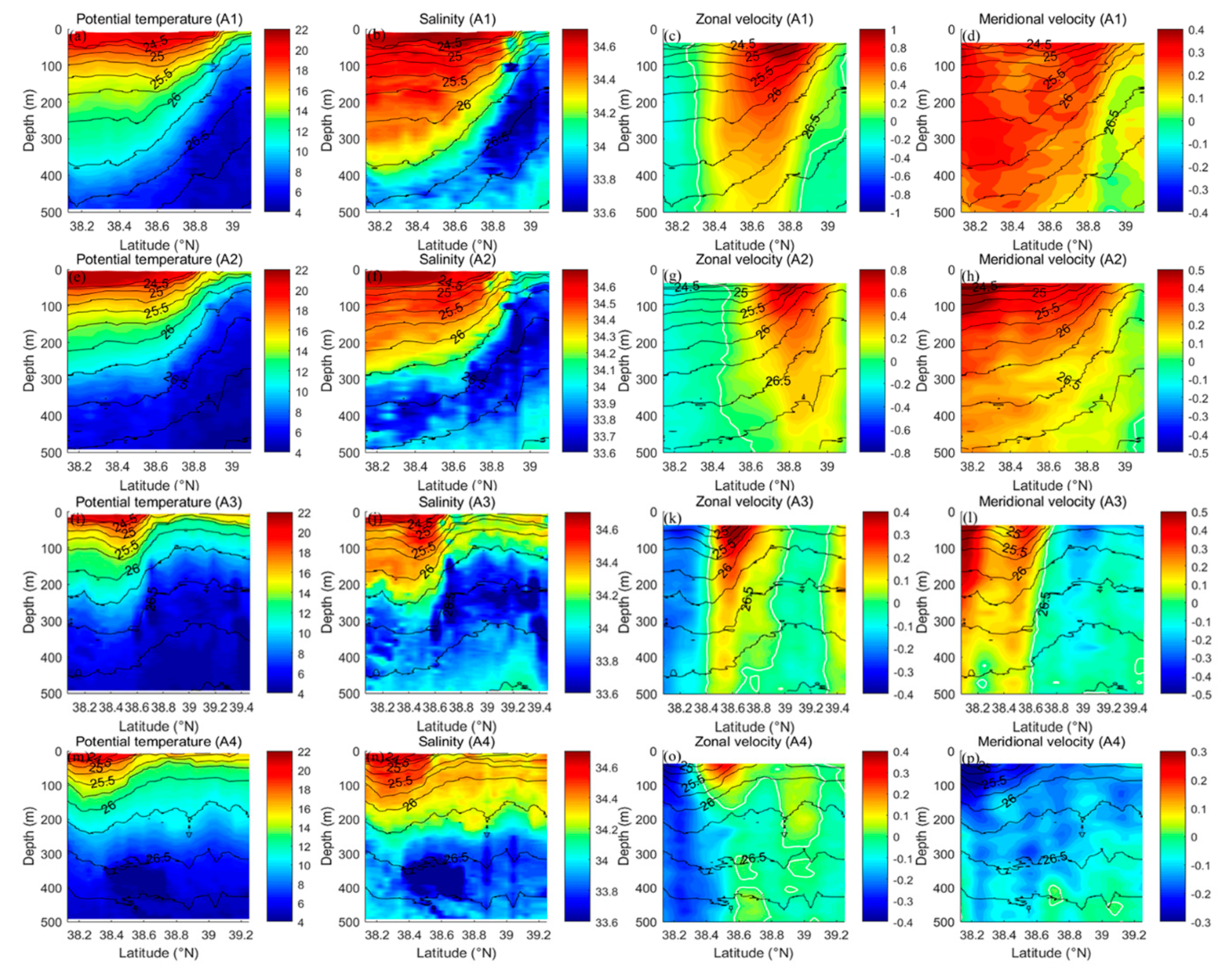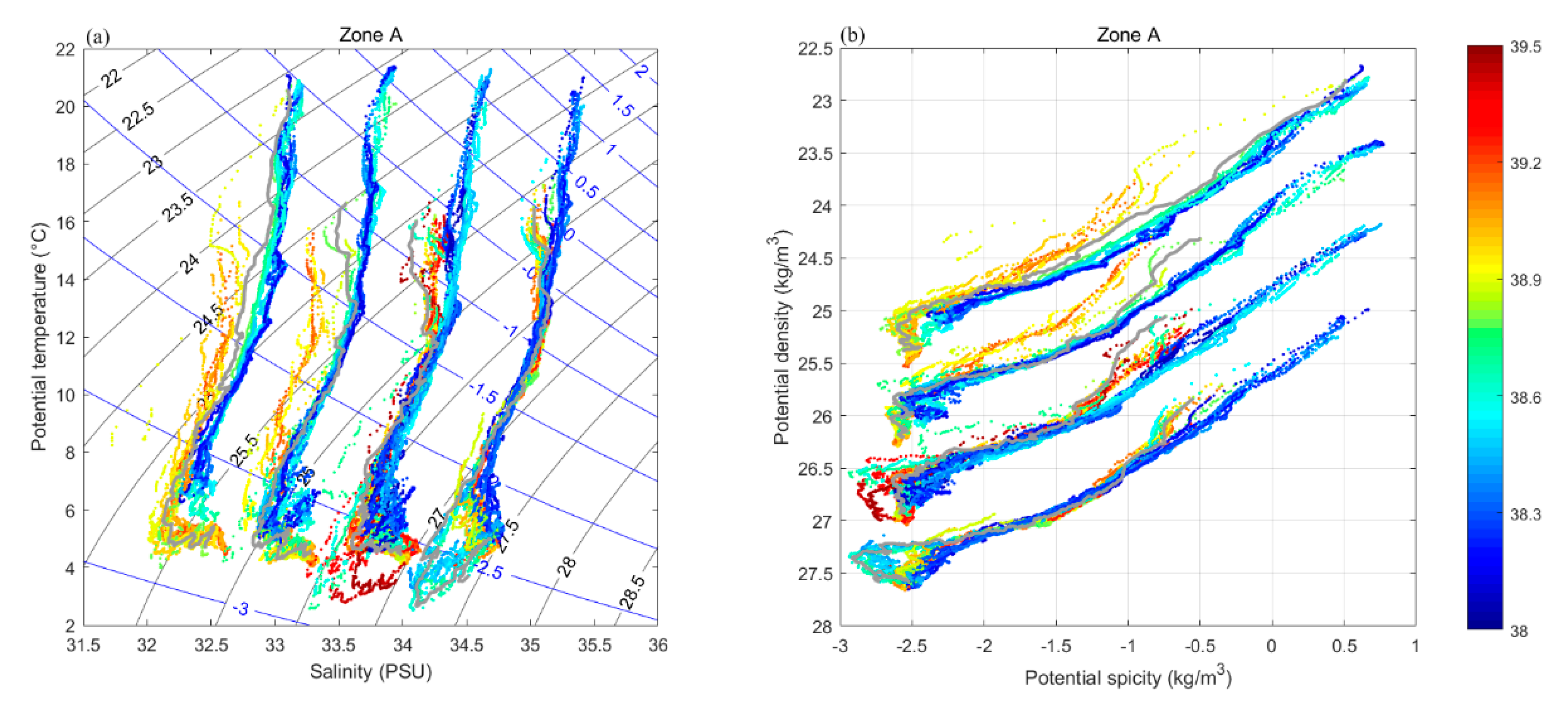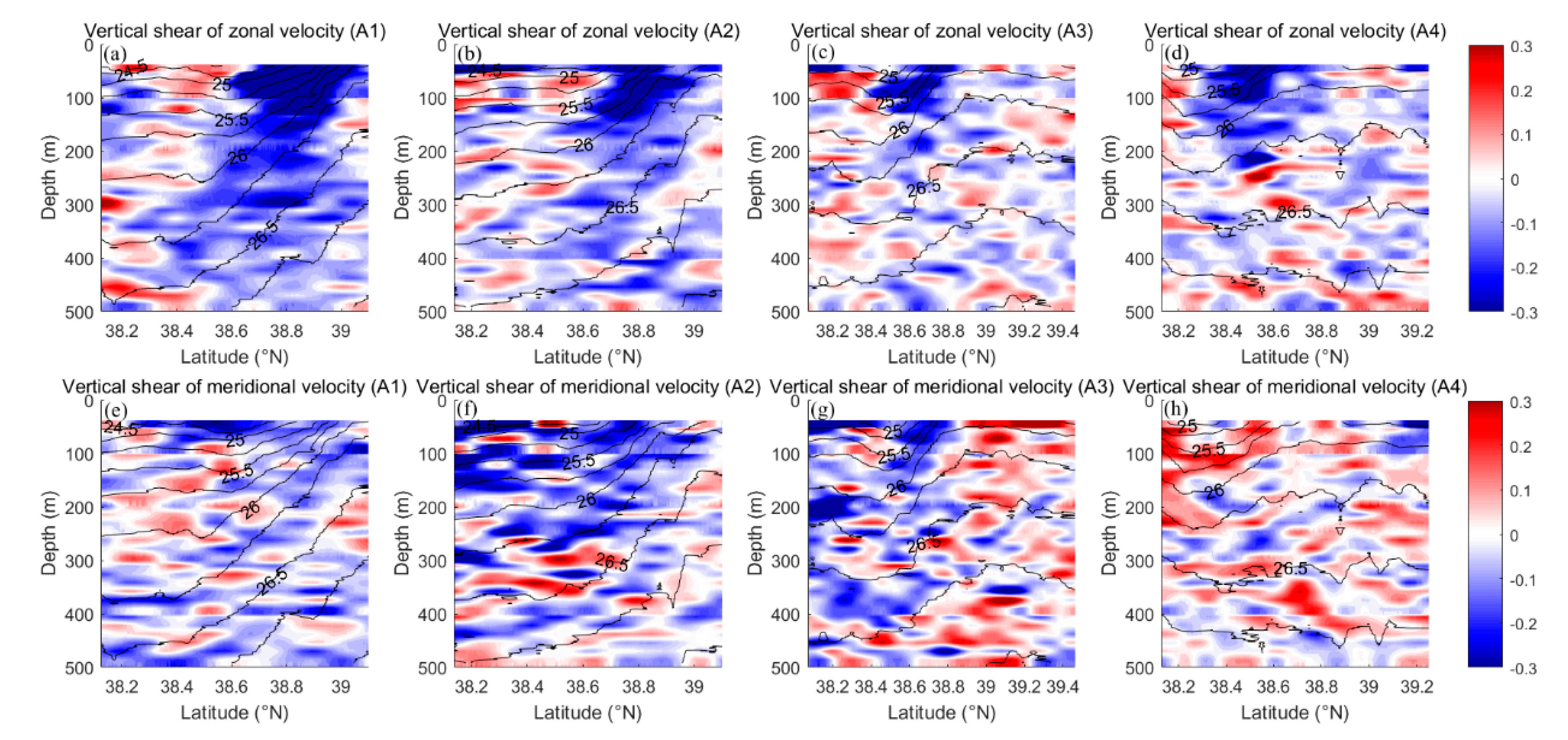Evolution and Structure of the Kuroshio Extension Front in Spring 2019
Abstract
:1. Introduction
2. Materials and Methods
2.1. Satellite Remote Sensing Data and In Situ Observations
2.2. Methods
3. Results
3.1. Evolution of Surface Thermal Kuroshio Extension Front from Satellite Measurements
3.2. Thermohaline and Velocity Structure across the Kuroshio Extension Front
3.3. Thermohaline Intrusions in the Frontal Zone
4. Summary and Discussion
Author Contributions
Funding
Acknowledgments
Conflicts of Interest
References
- Kawai, H. Hydrography of the Kuroshio Extension; University of Tokyo Press: Tokyo, Japan, 1972. [Google Scholar]
- Qiu, B.; Chen, S. Variability of the Kuroshio Extension Jet, Recirculation Gyre, and Mesoscale Eddies on Decadal Time Scales. J. Phys. Oceanogr. 2005, 35, 2090–2103. [Google Scholar] [CrossRef]
- Delman, A.S.; Mcclean, J.L.; Sprintall, J.; Talley, L.D.; Yulaeva, E. Effects of Eddy Vorticity Forcing on the Mean State of the Kuroshio Extension. J. Phys. Oceanogr. 2015, 45, 1356–1375. [Google Scholar] [CrossRef]
- Nagai, T.; Inoue, R.; Tandon, A.; Yamazaki, H. Evidence of enhanced double-diffusive convection below the main stream of the Kuroshio Extension. J. Geophys. Res. Oceans 2015, 120, 8402–8421. [Google Scholar] [CrossRef] [Green Version]
- Kida, S.; Mitsudera, H.; Aoki, S.; Guo, X.; Ito, S.I.; Kobashi, F.; Komori, N.; Kubokawa, A.; Miyama, T.; Morie, R.; et al. Oceanic fronts and jets around Japan: A review. J. Oceanogr. 2015, 71, 469–497. [Google Scholar] [CrossRef]
- Nagai, T.; Tandon, A.; Yamazaki, H.; Doubell, M.J.; Gallager, S. Direct observations of microscale turbulence and thermohaline structure in the Kuroshio Front. J. Geophys. Res. Oceans 2012, 117, C08013. [Google Scholar] [CrossRef] [Green Version]
- Ji, J.; Dong, C.; Zhang, B.; Liu, Y.; Zou, B.; King, G.P.; Xu, G.; Chen, D. Oceanic Eddy Characteristics and Generation Mechanisms in the Kuroshio Extension Region. J. Geophys. Res. Oceans 2018, 123, 8548–8567. [Google Scholar] [CrossRef]
- Wang, Y.; Yang, X.; Hu, J. Position variability of the Kuroshio Extension sea surface temperature front. Acta Oceanol. Sin. 2016, 35, 30–35. [Google Scholar] [CrossRef]
- Zhu, K.; Chen, X.; Mao, K.; Hu, D.; Hong, S.; Li, Y. Mixing Characteristics of the Subarctic Front in Kuroshio-Oyashio Confluence Region. Oceanologia 2019, 61, 103–113. [Google Scholar] [CrossRef]
- Nonaka, M.; Nakamura, H.; Tanimoto, Y.; Kagimoto, T.; Sasaki, H. Decadal variability in the Kuroshio–Oyashio Extension simulated in an eddy-resolving OGCM. J. Clim. 2006, 19, 1970–1989. [Google Scholar] [CrossRef] [Green Version]
- Nagai, T.; Clayton, S. Nutrient interleaving below the mixed layer of the Kuroshio Extension Front. Ocean Dyn. 2017, 67, 1027–1046. [Google Scholar] [CrossRef]
- Pauly, D.; Christensen, V. Primary production required to sustain global fisheries. Nature 1995, 374, 255–257. [Google Scholar] [CrossRef]
- Shcherbina, A.Y.; Gregg, M.C.; Alford, M.H.; Harcourt, R.R. Characterizing Thermohaline Intrusions in the North Pacific Subtropical Frontal Zone. J. Phys. Oceanogr. 2009, 39, 2735–2756. [Google Scholar] [CrossRef]
- Jan, S.; Wang, S.-H.; Yang, K.-C.; Yang, Y.J.; Chang, M.-H. Glider observations of interleaving layers beneath the Kuroshio primary velocity core east of taiwan and analyses of underlying dynamics. Sci. Rep. 2019, 9, 1–11. [Google Scholar]
- Itoh, S.; Kaneko, H.; Ishizu, M.; Yanagimoto, D.; Okunishi, T.; Nishigaki, H.; Tanaka, K. Fine-scale structure and mixing across the front between the Tsugaru Warm and Oyashio Currents in summer along the Sanriku Coast, east of Japan. J. Oceanogr. 2016, 72, 23–37. [Google Scholar] [CrossRef]
- Richards, K.; Banks, H. Characteristics of interleaving in the western equatorial Pacific. J. Geophys. Res. Oceans 2002, 107, 24-1–24-12. [Google Scholar] [CrossRef]
- Ruddick, B.; Kerr, O. Oceanic thermohaline intrusions: Theory. Progr. Oceanogr. 2003, 56, 483–497. [Google Scholar] [CrossRef]
- Ruddick, B.; Richards, K. Oceanic thermohaline intrusions: Observations. Prog. Oceanogr. 2003, 56, 499–527. [Google Scholar] [CrossRef]
- Stern, M.E. Lateral mixing of water masses. Deep Sea Res. Oceanogr. Abstr. 1967, 14, 747–753. [Google Scholar] [CrossRef]
- Ruddick, B.; Gargett, A.E. Oceanic double-infusion: Introduction. Prog. Oceanogr. 2003, 56, 381–393. [Google Scholar] [CrossRef]
- Nakano, H.; Tsujino, H.; Sakamoto, K.; Urakawa, S.; Toyoda, T.; Yamanaka, G. Identification of the fronts from the Kuroshio Extension to the Subarctic Current using absolute dynamic topographies in satellite altimetry products. J. Oceanogr. 2018, 74, 393–420. [Google Scholar] [CrossRef]
- Peilong, Y.; Lifeng, Z.; Yongchui, Z.; Bing, D. Interdecadal change of winter SST variability in the Kuroshio Extension region and its linkage with Aleutian atmospheric low pressure system. Acta Oceanol. Sin. 2016, 35, 24–37. [Google Scholar]
- Jing, Z.; Chang, P.; Shan, X.; Wang, S.; Wu, L.; Kurian, J. Mesoscale SST Dynamics in the Kuroshio–Oyashio Extension Region. J. Phys. Oceanogr. 2019, 49, 1339–1352. [Google Scholar] [CrossRef]
- Wang, Y.; Liu, W.T. Observational Evidence of Frontal-Scale Atmospheric Responses to Kuroshio Extension Variability. J. Clim. 2015, 28, 9459–9472. [Google Scholar] [CrossRef]
- Taguchi, B.; Nakamura, H.; Nonaka, M.; Xie, S.-P. Influences of the Kuroshio/Oyashio Extensions on Air–Sea Heat Exchanges and Storm-Track Activity as Revealed in Regional Atmospheric Model Simulations for the 2003/04 Cold Season. J. Clim. 2009, 22, 6536–6560. [Google Scholar] [CrossRef] [Green Version]
- Ullman, D.S.; Hebert, D. Processing of Underway CTD Data. J. Atmos. Ocean. Technol. 2014, 31, 984–998. [Google Scholar] [CrossRef] [Green Version]
- Liu, Y.; Weisberg, R.H.; Lembke, C. Glider Salinity Correction for Unpumped CTD Sensors across a Sharp Thermocline; Academic: Boston, MA, USA, 2015. [Google Scholar]
- Shen, J. Application of CODAS system in ship-mounted ADCP data quality control in Xiamen Bay. J. Appl. Oceanogr. 2014, 33, 472–480. (In Chinese) [Google Scholar]
- Xiang, W.; Wei, G.; Ji, F. Research of data processing and quality control for vessel mounted ADCP. Mar. Sci. Bull. 2014, 6, 101–105. (In Chinese) [Google Scholar]
- Mohn, C.; Denda, A.; Christiansen, S.; Kaufmann, M.; Peine, F.; Springer, B.; Turnewitsch, R.; Christiansen, B. Ocean currents and acoustic backscatter data from shipboard ADCP measurements at three North Atlantic seamounts between 2004 and 2015. Data Br. 2018, 17, 237–245. [Google Scholar] [CrossRef]
- Wu, Y.; Wu, Z.; Li, Z. Shipborne ADCP Data Processing. Hydroaphic Surv. Charting 2014, 34, 36–39. (In Chinese) [Google Scholar]
- Yuan, X.; Talley, L.D. The subarctic frontal zone in the North Pacific: Characteristics of frontal structure from climatological data and synoptic surveys. J. Geophys. Res. Oceans 1996, 101, 16491–16508. [Google Scholar] [CrossRef]
- Huang, R.X.; Yu, L.-S.; Zhou, S.-Q. New definition of potential spicity by the least square method. J. Geophys. Res. Oceans 2018, 123, 7351–7365. [Google Scholar] [CrossRef] [Green Version]
- McDougall, T.J.; Giles, A.B. Migration of intrusions across isopycnals, with examples from the Tasman Sea. Deep Sea Res. Part A Oceanogr. Res. Pap. 1987, 34, 1851–1866. [Google Scholar] [CrossRef]
- Ruddick, B. A practical indicator of the stability of the water column to double-diffusive activity. Deep Sea Res. Part A Oceanogr. Res. Pap. 1983, 30, 1105–1107. [Google Scholar] [CrossRef]
- Talley, L.D.; Yun, J.-Y. The Role of Cabbeling and Double Diffusion in Setting the Density of the North Pacific Intermediate Water Salinity Minimum. J. Phys. Oceanogr. 2001, 31, 1538–1549. [Google Scholar] [CrossRef]
- Smith, K.S.; Ferrari, R. The Production and Dissipation of Compensated Thermohaline Variance by Mesoscale Stirring. J. Phys. Oceanogr. 2009, 39, 2477–2501. [Google Scholar] [CrossRef]
- Toole, J.M.; Georgi, D.T. On the dynamics and effects of double-diffusively driven intrusions. Prog. Oceanogr. 1981, 10, 123–145. [Google Scholar] [CrossRef]
- McDougall, T.J. Double-diffusive interleaving. Part I: Linear stability analysis. J. Phys. Oceanogr. 1985, 15, 1532–1541. [Google Scholar] [CrossRef] [Green Version]
- Rainville, L.; Pinkel, R. Observations of Energetic High-Wavenumber Internal Waves in the Kuroshio. J. Phys. Oceanogr. 2004, 34, 1495–1505. [Google Scholar] [CrossRef]
- Beal, L.M. Is Interleaving in the Agulhas Current Driven by Near-Inertial Velocity Perturbations? J. Phys. Oceanogr. 2007, 37, 932–945. [Google Scholar] [CrossRef]







| Section | Location | Time | Heading Direction | Number of Stations |
|---|---|---|---|---|
| A1 | 151.74°–151.53° E, 38.11°–39.19° N | 28 May 2019 | Southeast to Northwest | 21 |
| A2 | 151.06°–151.32° E, 39.17°–38.14° N | 28 May 2019 | Northwest to Southeast | 21 |
| A3 | 151.17°–150.61° E, 38.12°–39.46° N | 29 May 2019 | Southeast to Northwest | 27 |
| A4 | 149.73°–150.50° E, 39.26°–38.13° N | 29 May 2019– 30 May 2019 | Northwest to Southeast | 28 |
© 2020 by the authors. Licensee MDPI, Basel, Switzerland. This article is an open access article distributed under the terms and conditions of the Creative Commons Attribution (CC BY) license (http://creativecommons.org/licenses/by/4.0/).
Share and Cite
Wang, J.; Mao, K.; Chen, X.; Zhu, K. Evolution and Structure of the Kuroshio Extension Front in Spring 2019. J. Mar. Sci. Eng. 2020, 8, 502. https://doi.org/10.3390/jmse8070502
Wang J, Mao K, Chen X, Zhu K. Evolution and Structure of the Kuroshio Extension Front in Spring 2019. Journal of Marine Science and Engineering. 2020; 8(7):502. https://doi.org/10.3390/jmse8070502
Chicago/Turabian StyleWang, Jiahao, Kefeng Mao, Xi Chen, and Kelan Zhu. 2020. "Evolution and Structure of the Kuroshio Extension Front in Spring 2019" Journal of Marine Science and Engineering 8, no. 7: 502. https://doi.org/10.3390/jmse8070502





